Edozie etal
IAA Journal of Scientific Research 10(1):36-48, 2023.
©IAAJOURNALS
Automated Hybrid Smart Door Control System
www.iaajournals.org
ISSN: 2736-7319
Enerst Edozie1 , Eze Val Hyginus Udoka2, Ibrahim Mohamed Jama1 and Bwire Ivan11DepartmentofElectricalEngineering,KampalaInternationalUniversity,Uganda.
2DepartmentofPublicationandExtension,KampalaInternationalUniversity,Uganda.
Corresponding Author: udoka.eze@kiu.ac.ug
ABSTRACT
This research paper successfully designed, developed and implemented an automated hybrid smart door control system which has the ability to secure a home up to 92% electronically. This smart door system is designed and implemented by building a hardware made up of the Bluetooth module and fingerprint scanner which are interfaced with the Microcontroller system that uses +5V power supply. The written programs were interfacedintothe microcontrollerchipsbypluggingtheArduinoUSBcableintothelaptop and upload the codes. The microcontroller chips helped in enrolling the users fingerprint into the fingerprint scanner and it automatically administers and saves the users fingerprint after enrollment. Furthermore, after all the processes the user places the enrolledorregisteredfingerintothe fingerprintscannerwhicheitheracceptsordeniesthe user by triggering the solenoid lock to either unlock, lock or deny access. This process of unlocking andlocking requires using Bluetooth andfingerprintto eitherlockor unlockthe door smartly without stress and it can be done within one second that is why the Solenoid lock is used in building this security system. This automated hybrid smart door control system developed has curbed the problem of door breaking theft for about 92%, strengthened security and as well made it so easy for the physically challenged people to haveaccesstotheirhomeswithoutthirdpartyassistance.
Keywords:SmartDoorSystem,Fingerprint,Bluetooth,Security,Arduino,Microcontroller.
INTRODUCTION
Smart Home System (SHS) is a dwelling incorporating a communications network that connects the electrical appliances andservicesallowingthemtoberemotely controlled, monitored and accessed [1, 2, 3, 4, 5, 6, 7]. SHS includes different approaches to achieve multiple objectives range from enhancing comfort in daily life to enabling a more independent life for elderly and handicapped people [8, 9, 10, 11, 12, 13] Security has become a very challenging concern in the twenty first century where everybody wants to feel safe at every point in time more especially at home, workplace and its environs at large [5, 14, 15, 16]. To feel safe and guarded to a certain extent at home there are many electronic and artificial intelligent gargets that were mainlydesignedtofacilitateit[17,18,19, 20].Thosedesignedgargetssuchasmetal
dictator, automatic door alert and so on does not still provide sufficient security in this twenty first century. Due to this security threats and high rate of crime being recorded on daily bases at home, there calls for a need to improve home securities electronically. One of these artificial intelligent and electronic door securities systems used in Smart door security system are Bluetooth based smart door, image break based smart door, retina based smart door, remote control based smart door, finger print based smart door and Radio frequency identification (RFID) smart doors [21, 22, 23,24].
TheRFIDandbiometric systemsoflockis an excellent method to make a door smart, due to its ability to use artificial intelligent and electronic mechanism to operate [25, 26, 27, 28]. The use of
Bluetooth and smartphone is much easier to adopt and use because of its simplicity [29, 30, 31]. This proposed automated hybrid smart door system gives the user more access to communicate with the door and as well offers a diverse opportunity for the physically challenged persons that might not have a finger or the crippled to use RFIDor biometric lock respectively. Furthermore, with the design and implementation of automated hybrid smart door system the physically challenged can simply access their doors either with finger or by single click in device[32,33,34,35,36].
A researcher in [6] did a very extensive work on Design and Implementation of a Reliable Wireless Real-Time Home AutomationSystemBasedonArduinoUno Single-Board Microcontroller. The researcher’s design and implementation concepts for a wireless real-time home automation system based on Arduino Uno microcontrollerascentralcontrollers.The proposed designed system has two operational modes. The first operational mode is manually-automated mode where the user can monitor and control the appliances at home from anywhere using the cellular phone through Wi-Fi communication technology [37, 38]. The second operating mode is the selfautomated mode which makes the controllers to be capable of monitoring and controlling different appliances at home automatically in response to the signals that comes from the related sensors. The hardware was implemented using Matlab-GUI platform for reliability and effectiveness. The advantage of this design is its simplicity, cost effectiveness andflexibilitybutthedisadvantageisthat ithas onlyone systemof operation which is internet based and secondly its durabilityisnotfeasible.
In [1], the author focused mainly on four fields for SHS which are, home automation and remote monitoring, environmental monitoring, including humidity, temperature, fault tracking and management and finally health monitoring. The system design is based on the Microcontroller MIKRO C software; multiple passive and active sensors and also a wireless internet services which is
used in different monitoring and control processes. This paper presents the hardware implementation of a multiplatform control system for house automation and combines both hardware and software technologies. The system results showed that it can be classified as a comfortable, secure, private, economic and safe system in addition to its great flexibility and reliability. The disadvantage of this SHS is that it is not robust, its circuit complexity and never considered the handicapped ones. Due to this disadvantage, it has not solved the problem of robustness and ease of implementation.
There are many other smart door systems designed in different area by different authors as in [7,8,9,10,11] which curbed the problems of theft and insecurity to a certain level but never eradicated it. From the extensive review we were above to find out that there are many problems associated with smart door system such as: (1) they lack robustness and has complex circuit. (2) It lacks versatility: it does not consider the handicapped and disables (3) It lacks durability: it easily got spoilt and most at times abandoned due to its fragile and hybridized nature. There are also problems of unsteady power supply in African and for effective andefficientutilizationofthissmartdoor system there must be a steady power supply. The effectiveness and robustness of this smart door design will be well felt when renewable sources of Energy (Solar photovoltaic) is incorporated in it [12, 13]. Author in [14,15,16,17] reviewed, developed, fabricated and optimized solar photovoltaic panels and from that it can be drawn that solar photovoltaic sources of energy will be best used as an alternative/supplementary sources of power supply to the smart door system. Thisproposeddesignandimplementation of automated smart door system will be more user friendly, has less circuit complexity and has alternative power supply in case of power failure. This project will also consider and admit the physically challenged people by giving them the privilege to access the door whilesittingontheirwheelchairs,resting sofas or sleeping bed through Bluetooth.
The main objective of this research is to construct a two-way access control system using fingerprint sensor and BluetoothModule.
MATERIALS AND METHODS
This is a microcontroller board based on the ATmega328p. It has 14 digital input/output pins (of which 6 can be used as PWM outputs), 6 analog inputs, a 16 MHz ceramic resonator, a USB connection, a power jack, and a reset button. It contains everything
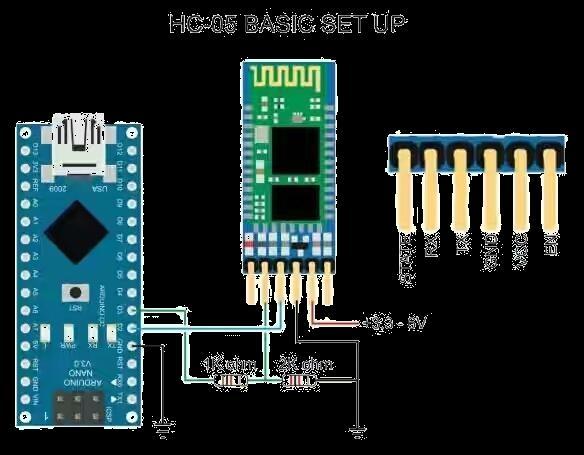
needed to support the microcontroller. We either need to connect it to a computer using a USB cable or power it with an AC-to-DC adapter [17][18][19]. The Arduino circuit acts as an interface between the software part and the hardware partoftheproject.
Bluetooth is a wireless technology standard for exchanging data over short distances (using short-wavelength UHF radio waves in the ISM band from 2.4 to 2.485GHz)fromfixedandmobiledevices
and building Personal Area Networks (PANs). The Bluetooth module being used allows us to transmit and receive signals. It receives the text from the Android phone and transmits it to the serial port oftheArduinoUno.
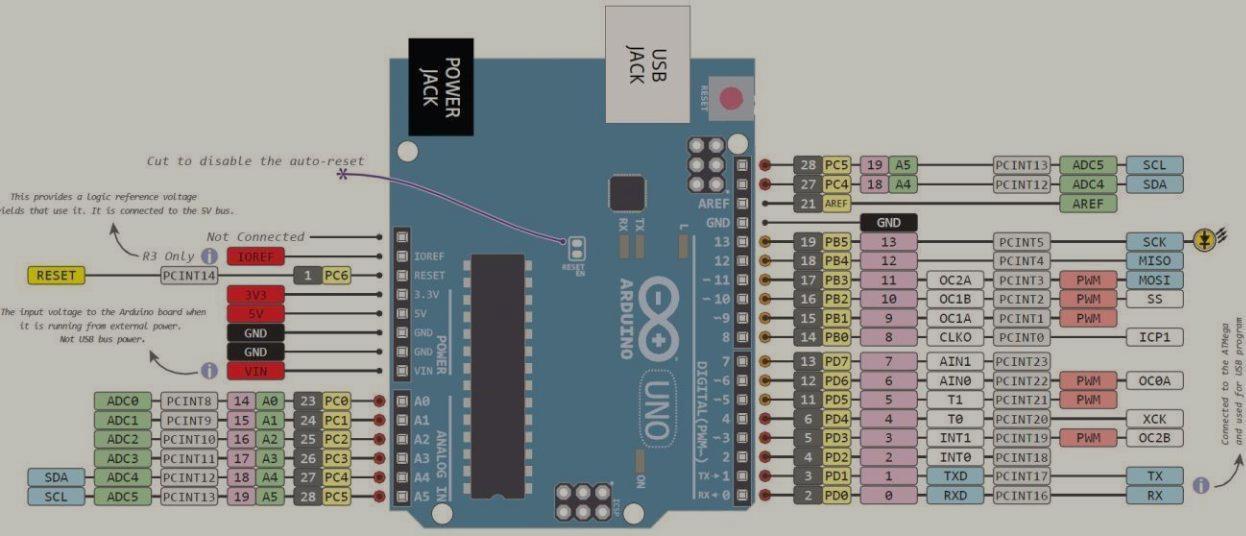
Table1: Bluetooth Module functional keys
Solenoids are basically electromagnets: theyare made of a big coil of copper wire with an armature (a slug of metal) in the middle. It is basically used for electronic lock and when 9-12VDC is applied, the slug pulls and the door opens. The
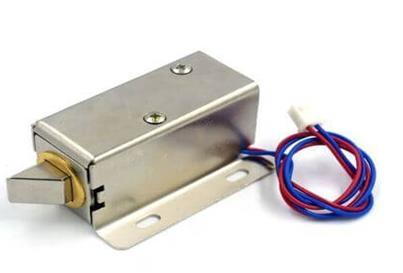
solenoids come with the slanted slug as shown in figure 3 and it enables user to configure it to any angle (90, 180 or 270 degrees) so that it matches the door configuration position
withpolarizers to display results/output Figure 4 is the LCD module that will be used to display the output of this proposed prototype. The display has 8
Edozie etal
pinswhichareconnecteddirectlyintothe microcontroller. It displays 16 characters
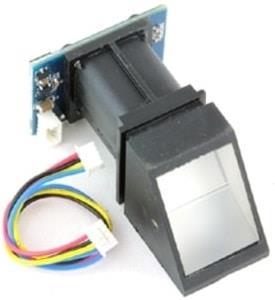
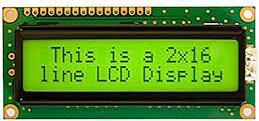
www.iaajournals.org
by 2 lines; the characters are black againstagreenbackground[20].
5. Fingerprint scanner
A fingerprint scanner is a type of technology that identifies and authenticates the fingerprints of an
individual in order to grant or deny accesstoacomputersystemoraphysical facility.
Working Principles of the Proposed Automated Hybrid Smart Door Control System (AHSDCS) The working mechanism and principals of AHSDCS is represented in the flowchart as shown in figure6.Eachunitoftheflowchart willbe
explained extensively as we unfold its functions. The AHSDCS is made up of some important units which will be detailed together with its circuit connectionsandprograming.
This is the unit in which command is given to start the execution of a program and in this project the smartphone and Fingerprint Scanner are the devices that servethepurposeofsendingcommandas input. The mobile smartphone sends signal when connection is established between the devices (Bluetooth module (HC-05) and the fingerprint scanner). The Devices send the input commands through a developed application to the device modules with respect to the devicestheuserisusingatthatparticular
time. The device through the written applications gives the user access to try the other module (alternative) when the first one fails. The input command can only be executed when and only when a Bluetooth connection is established between the device and the module and be operated within Bluetooth range limit or when the finger image saved in the system is scanned by the fingerprint scanner[21,22]
Receiver Unit
This unit deals primarily with the receiving of command signals sent from the input. The command sent by the mobile smartphone or fingerprintscanner is received in this unit with the help of a Bluetooth module (HC-05) and fingerprint module respectively. The Bluetooth module also serves as a link to establish connection between the mobile device andtheArduinomicrocontroller.
Processing Unit
This is a unit where command to execute, how to execute it, when to execute it and where to execute were determined. The Arduino microcontroller serves the purpose of processing the command of this project. The Arduino receives the commandfromthemobilesmartphoneon what command to execute via the Bluetooth module or fingerprint module and then the microcontroller determines what function to perform and how to perform the particular task and give the required output of the given task. The Arduino that serves as the main processing unit has two units the hardware (which is the microcontroller) and the Integrated Development Environment (IDE) which comprises of software program that runs the whole operatingsystem.
Smartphone Application
The Android phone used in this research design and implementation was programed to select any home appliance from the options that appear in the App which gives the user access to select either open or close. The user cannot run the App from outside the house unless within the Bluetooth range related with the Bluetooth module. It allows establishing point-to-point connection with Bluetooth support devices. The Android Software Development Kit (SDK) provides all necessary tools to develop Android Application (API). The Android usesapkfiletoinstall theapplicationand the code was written in Android Studio IDE
Output Unit
This is the stage at which the output is being displayed where the Solenoid lock is the device used to either open or close the door through the help of the commands. When the Solenoid lock receives the command from the microcontroller to open it moves its position to ninety degrees which moves up and opens the slider while when the command is to close the servo motor moves to one hundred andeightydegrees which moves the slider to lock position whichclosesthedoor.
Circuit diagram is the final circuit where the whole components are combined and testedforefficiencyandeffectiveness.All the components used in this system was Programmed and tested separately for safety measures and matching with the right driver. Each component was
programmed separately with Arduino UNO using different Arduino IDE. Also, they were run in different computers. Later on, all were combined in a single Arduino IDE andimplementedfor real life application.
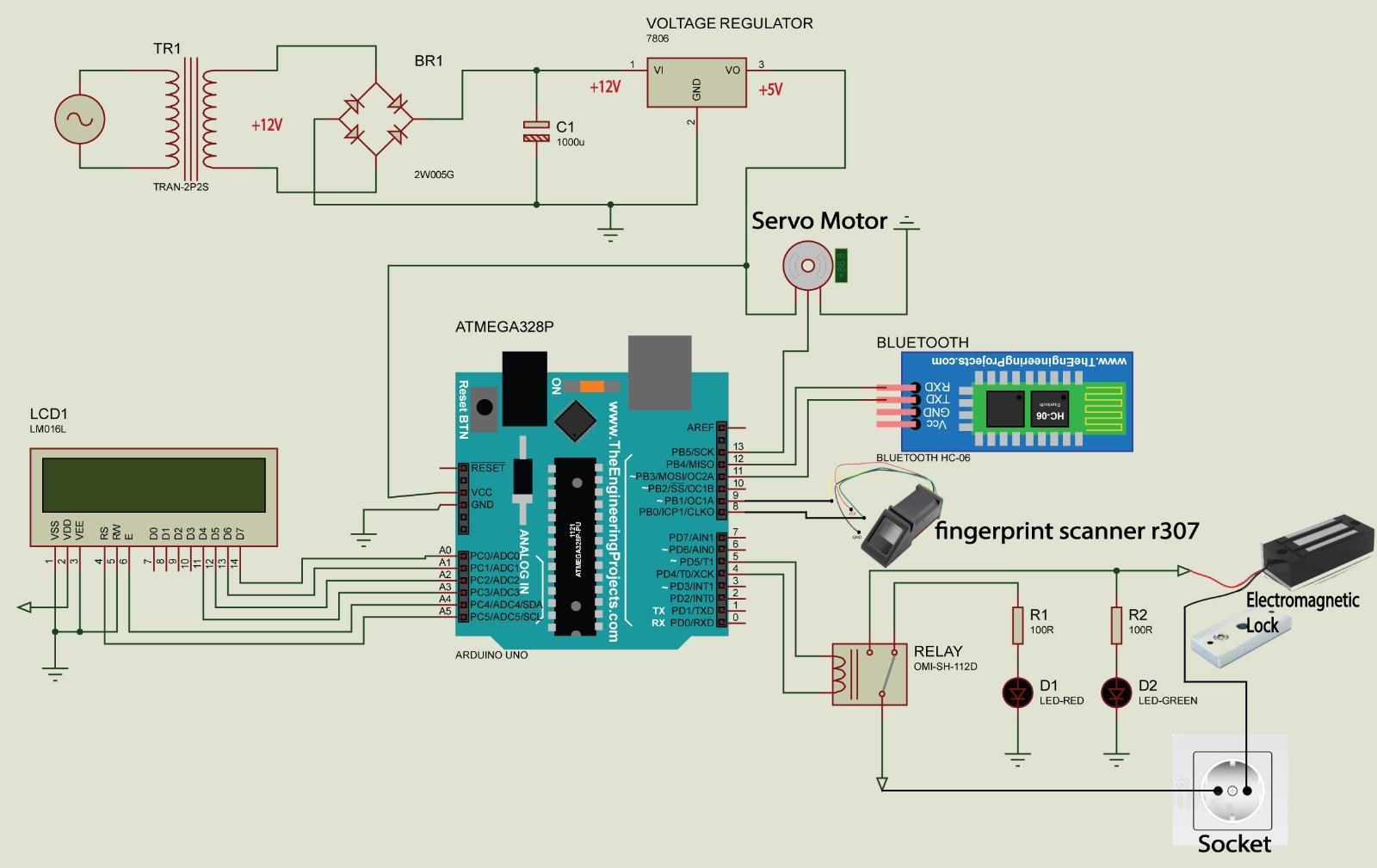
DISCUSSION
This research is based on improving the home security system which will identifies the Bluetooth App and register the owner’s fingerprint into the microcontroller using the fingerprint
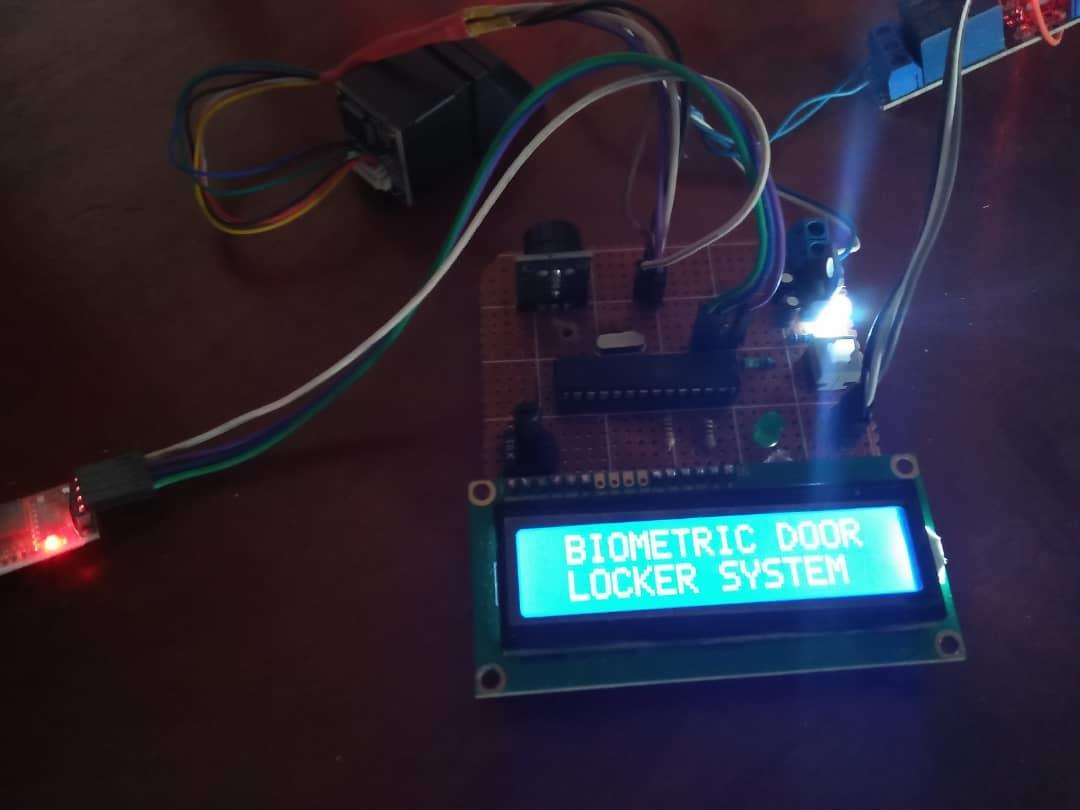
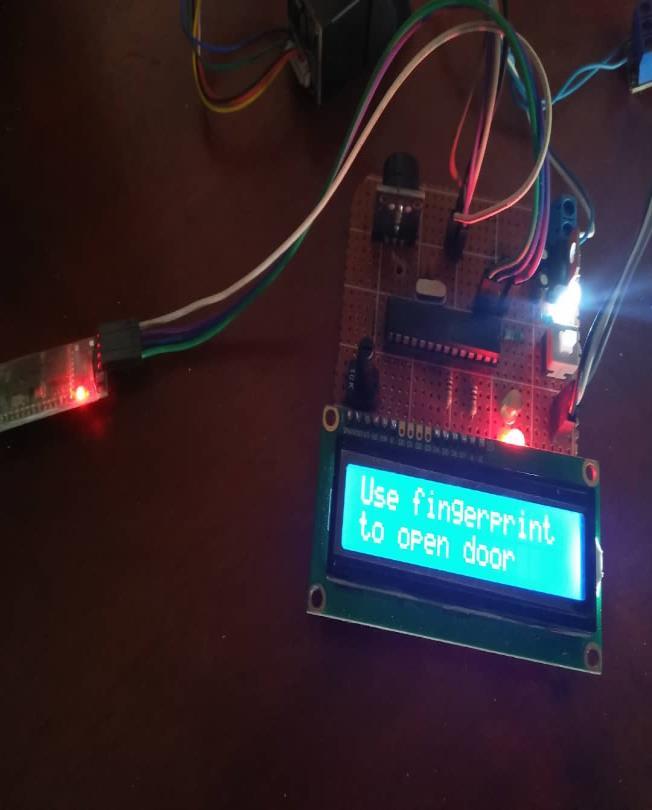
scanner or sensor. The Bluetooth module and fingerprint scanner are interfaced with the Microcontroller system that uses +5V power supply. The first thing to do after connecting the circuit diagram is to
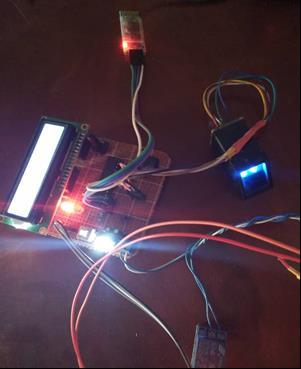
plug the Arduino USB cable to the laptop and upload the code into the microcontroller chips. This microcontroller chips will help in enrolling the fingerprint into the fingerprint scanner and it automatically administers and saves the users fingerprint after enrollment. This fingerprint scanner has the capacity of saving up to 137 different fingerprints of different individuals. The downloaded and installed Apk (Bluetooth app) will be connected to the hardware as shown in figure 8 The next step is for the user to turn on the smartphone Bluetooth and pair it with the HC06 Bluetooth module which will permit interactions between the devices.After these processes, the appwillbereadyforuseandtheuserwill be required to click on the Bluetooth icon
on his/her smartphone and then connect with the Bluetooth module HC06. Furthermore, immediately the phone is connected, the app will grant the user access to press unlock to access the door or lock to lock the door because there is embeddedinteractionbetweentheuser’s smart phone and the smart door to prevent unauthorized person from accessingthedoor.
Now when you place your thumb on fingerprint scanner after enrollment or registering process has been done, when accessisgranted thesolenoidlockwill be unlocked and when deniedthe access will not be granted. This process of unlocking andlocking requires less than one minute fortheprocessestobecompletedthat’s why the Solenoid lock is used in building thissecuritysystem.
CONCLUSION
This research paper has successfully developed, designed and implemented an Automated Hybrid Smart Door Control System using Arduino, fingerprint scanner and Bluetooth applications for a better household security and to as well allow the eligible disabled people access Automated Hybrid Smart Door Control System was successfully design using Arduino applications and coding was done using Arduino IDE platform. This developed research project has curbed the problems of door breaking thefts, given easy access to opening and closing of doors by the eligible people andfinally offered the eligible physically challenged people privilege to access the doors without assistance by the third party.
This project will help the world at large more especially Africans to curb door breaking thefts and as well offer easy access to the eligible users. This project willalsohelptoreduce costforthehouse owners as security guard responsible for assisting in opening/closings doors and gates for their employers will not be necessary anymore as the technology has taken over the duty as the eligible users can access the door comfortably without any assistance from the gateman. It is safe to say that the main objectives and the aim of this research project were achieved at very affordable cost which should be the earnest desire of any engineer.
REFERENCES
[1]. Mowad,M.A.E.,Fathy,A.andHafez, A. (2014). Smart Home Automated Control System Using Android Application and Microcontroller
International Journal of Scientific & Engineering Research, vol. 5, no. 5, pp.935–939.
[2]. Pandurang, B., Dhanesh, J., Pede, S., Akshay, G. and Rahul, G. (2016). Smart Lock: a Locking System Using Bluetooth Technology & Camera Verification. International Journal of TechnicalResearch and Applications, vol. 4, no. 1, pp. 136–139. [Online].
Available:www.ijtra.com
[3]. Hashim, N., Azmi, N. F. A.M., Idris, F. and Rahim, N. (2016). Smartphone activated door lock using WiFi ARPN Journal of Engineering and Applied Sciences, vol. 11, no. 5, pp. 3309–3312.
[4]. Mishra, S., Mohite, O. and Kharat, S. (2016). Smart Door Lock System Using Arduino www.irjmets.com
@International Research Journal of Modernization in Engineering, no. 04, pp. 1503–1507, 1503, [Online].
Available:www.irjmets.com
[5]. Eze, V. H. U., Ugwu, C. N. and Ugwuanyi, I. C. (2023). A Study of
Cyber Security Threats, Challenges in Different Fields and its Prospective Solutions: A Review
INOSR Journal of Scientific Research, vol.9,no.1,pp.13–24
[6]. Abu Sulayman, I. I. M., Almalki, S. H. A. and Soliman, M. S. (2015). Design and implementation of a reliable wireless real-time home automation system based on Arduino Uno single-board microcontroller
INTERNATIONAL JOURNAL OF CONTROL, AUTOMATION AND SYSTEMS, vol. 2015-Janua, no. December,pp.2760–2764
[7]. Madan, V. (2012). GSM-Bluetooth based Remote Monitoring and Control System withAutomaticLight Controller General Terms Remote Monitoring and Control Systems
International Journal of Computer Applications, vol. 46, no. 1, pp. 975–8887.
10.11648/j.ijics.20170206.11.
[12]. Eze, V. H. U., Iloanusi, O. N., Eze, M. C. and Osuagwu, C. C. (2017). Maximum power point tracking technique based on optimized adaptive differential conductance CogentEngineering,vol.4,no.1,pp. 1–13. Doi: 10.1080/23311916.2017.1339336.
[13]. Okafor, W. O., Edeagu, S. O., Chijindu, V. C., Iloanusi, O. N. and Eze, V. H. U. (2023). A Comprehensive Review on Smart Grid Ecosystem. IDOSR Journal of AppliedScience,vol.8,no.1,pp.25
63.
[14]. Eze,V.H.U.,Eze,M.C.,Chijindu,V., Chidinma, E., Samuel, E, U. A. and Chibuzo, O. C. (2022). Development of Improved Maximum Power Point Tracking Algorithm Based on Balancing Particle Swarm Optimization for Renewable Energy Generation. International Digital Organization for Scientific Research of Applied Science, vol. 7, no. 1, pp. 12–28.
2251. Doi:
[8]. Javare, A., Ghayal, T., Dabhade, J., Shelar, A. and Gupta, A. (2018). Access control and intrusion detection in door lock system using Bluetoothtechnology,” International Conference on Energy, Communication, Data Analytics and Soft Computing, ICECDS 2017, pp. 2246
10.1109/ICECDS.2017.8389852.
[9]. Aman, F. and Anitha, C. (2018). Motion sensing and image capturing basedsmartdoor systemon android platform 2017 International Conference on Energy, Communication, Data Analytics and Soft Computing, ICECDS 2017, pp. 2346
[15]. Eze, V. H. U., Oparaku, U. O., Ugwu, A. S. and Ogbonna, C. C. (2021). A Comprehensive Review on Recent Maximum Power Point Tracking of a Solar Photovoltaic Systems using Intelligent , Non-Intelligent and Hybrid based Techniques. International Journal of Innovative Science and Research Technology, vol.6,no.5,pp.456–474
2350. Doi:
10.1109/ICECDS.2017.8389871.
[10]. Saravanan, S. K., Nainar, M. A. and Marichamy, V. S. (2019). Android Based Smart Automation System Using Multiple Authentications
Iconic Research Engineering Journals,vol.3,no.6,pp.59–65.
[11]. Quadri, B. A. (2017). A Digitalized Smart Mobile Home Automation and Security System via Bluetooth/Wi-Fi Using Android Platform,” International Journal of Information and Communication Sciences, vol. 2, no. 6, p. 93. Doi:
[16]. Eze, M. C. etal. (2021). Solar Energy Materials and Solar Cells Optimum silver contact sputtering parameters for efficient perovskite solar cell fabrication Solar Energy Materials and Solar Cells, vol. 230, no. 2020, p. 111185 doi: 10.1016/j.solmat.2021.111185.
[17]. Eze,V.H.U., Olisa,S.C., Eze,M.C., Ibokette, B. O. and Ugwu, S. A. (2016). Effect of input current and the receiver-transmitter distance on the voltage detected by infrared receiver. International Journal of Scientific & Engineering Research, vol.7,no.10,pp.642–645
[18]. Eze, V. H. U., Onyia, M. O., Odo, J. I. andUgwu,S.A.(2017).Development
Edozie etal
Of Aduino Based Software For Water Pumping Irrigation System. International Journal of Scientific & Engineering Research, vol. 8, no. 8, pp.1384–1399
[19]. Eze, M. C., Eze, H. U., Chidebelu, N. O., Ugwu, S. A., Odo, J. I. and Odi, J. I.(2017).NovelPassiveNegativeAnd Positive Clamper Circuits Design For Electronic Systems. International Journal of Scientific & Engineering Research,vol.8,no.5,pp.856–867
[20]. Edozie, E and Vilaka, K. (2020). Design and Implementation of a Smart Sensor and RFID Door Lock Security System with Email Notification. International Journal of EngineeringandInformationSystems (IJEAIS), 4(7),25-28.
[21]. Edozie, E., Janat, W., Kalyankolo, Z., Adabara, I. and Ukagwu, K. J. (2020). Design and Analysis of a Lab IP Spy Camera and Alarm System using Raspberry Pi and ATMEGA328P. System,4(5),16-20.
[22]. Design and Implementation of an IP Camera Tracking Robotic System usingRaspberryPi3BEEdozie
[23]. AbdulfatahA Yusuf,Hadijah Yahyah, AtikuAFarooq,KasumbaABuyondo, Peter W Olupot, Sharif S Nura, Tajuddeen Sanni, Twinomuhwezi Hannington, Zubeda Ukundimana, Abdurrahman S Hassan, Mustafa M Mundu, Sibuso S Samede, Yakubu A Makeri, Milon D Selvam(2021). Characteristics of ultrafine particle emission from light-vehicle engine at city transport-speed using aftertreatment device fueled with nbutanol-hydrogen blend. Case Studies in Chemical and Environmental Engineering,3:100085.
[24]. Furaha Kasali Jean-Rostand, Mundu M Mustapha, Ibrahim Adabara, Abdurrahman S Hassan (2019). Design of an automatic transfer switch for households solar PV system. European Journal of Advances in Engineering and Technology,6(2):54-65.
[25]. Nnamchi SN, MM Mundu, JD Busingye, JU Ezenwankwo (2019). Extrinsic modelingandsimulationof
www.iaajournals.org
helio-photovoltaic system: a case of single diode model. International journal of green energy.16(6): 450467.
[26]. Stephen Ndubuisi Nnamchi, Muhamad Mustafa Mundu, Onyinyechi Adanma Nnamchi, Uche Onochie, Zaid Oluwadurotimi Jagun (2022). Modeling Earth Systems and Environment,8(2):2383-2400.
[27]. Stephen Ndubuisi Nnamchi, Mustafa Muhamad Mundu (2022). Development of solar isodose lines: Mercatorian and spatial guides for mapping solar installation areas. Heliyon,8(10):e11045.
[28]. Stephen Ndubuisi Nnamchi, Onyinyechi Adanma Nnamchi, Oluwatosin Dorcas Sanya, Mustafa Muhamad Mundu, Vincent Gabriel (2020). Dynamic analysis of performance of photovoltaic generators under moving cloud conditions. Journal of Solar Energy Research,5(2):453-468.
[29]. Kizito BW (2023). An SMS-Based ExaminationRelayingSystem:ACase Study of Kampala International University Main Campus. IDOSR Journal of Science and Technology 9 (1),1-26.
[30]. Ogbonna Chibuzo C., U. Eze Val Hyginus, S. Ikechuwu Ezichi, O. OkaforWisdom,C.AnichebeOnyeke, U. Oparaku Ogbonna (2023). A Comprehensive Review of Artificial Neural Network Techniques Used for Smart Meter-Embedded forecasting System. IDOSR Journal of Applied Sciences,8(1):13-24.
[31]. Patience Nabiryo, Anthony Ejeh Itodo (2022) Design and Implementation of Base Station Temperature Monitoring System Using Raspberry Pi, IDOSRJournalof ScienceandTechnology, 7(1):53-66.
[32]. Hamisi Sekiti and Adabara Ibrahim (2022). Security Analysis for Virtual Private Network Based on Site to Site Circuit Switching (Vpns2scs) Case Study: Liquid Telecommunication Ggaba. IDOSR Journal of Computer andAppliedSciences 7(1):95-108.
[33]. Kalulu Mathias (2022). The Smart Grid and Its Security Challenges,
Edozie etal
INOSRAppliedSciences9(1):9-12.
[34]. Kalulu Mathias and Adabara Ibrahim (2022). Developing of a Smart Fraud Detection System in Advanced Metering Infrastructure Using Deep Learning. INOSR APPLIED SCIENCES 9(1):1-8.
[35]. Nabiryo Patience and Itodo Anthony Ejeh (2022). Design and Implementation of Base Station Temperature Monitoring System UsingRaspberryPi.IDOSRJournalof ScienceandTechnology7(1):53-66.
[36]. Masisani William Mufana and Adabara Ibrahim (2022). Implementation of Smart Grid
www.iaajournals.org
Decision Support Systems. IDOSR Journal of Scientific Research 7(1) 50-57,
[37]. Natumanya Akimu (2022). Design and Construction of an Automatic Load Monitoring System on a Transformer in Power Distribution Networks. IDOSR Journal of ScientificResearch7(1)58-76.
[38]. Kisakye Rebecca (2022).Simulation and Analysis of Dipole Transmitter Antenna (KIU Laboratory) IDOSR Journal of Computer and Applied Sciences 7(1):119-135.
